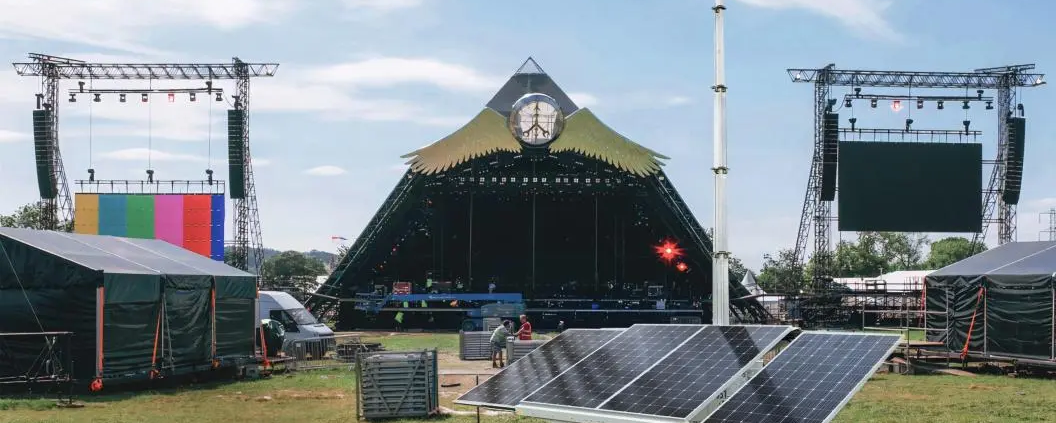So wählen Sie den LED-Solarbeleuchtungsturm mit Hybridenergieoptionen
Auswahl des richtigen LED-Solarbeleuchtungsturms mit Hybridenergieoptionen
Berücksichtigen Sie bei der Auswahl eines Solarlichtmasts mit gemischten Energiequellen (Solar, Wind, Diesel, Netz) die Beleuchtungsanforderungen, Reichweite, Funktionalität, Laufzeit und spezifischen Standortbedingungen.
Schnellvergleich (drei gängige Modelle für das erste Screening)
- Kleiner Solarturm — Höhe: 6 m; Reichweite: ~750 m²; Lichtleistung: ~33.000 lm; Akkupack: ~9,6 kWh; Laufzeit: ~28,8 h (abhängig von der Helligkeit).
- Mittlerer mobiler Beleuchtungsanhänger — Höhe: 9 m; Reichweite: ~1.500 m²; Lichtleistung: ~66.000 lm; Akkupack: ~14,4 kWh; Laufzeit: ~20 h.
- Großer tragbarer Beleuchtungsanhänger — Höhe: 12 m; Reichweite: ~2.200 m²; Lichtleistung: ~198.000 lm; Akkupack: ~28,8 kWh; Laufzeit: ~20 h.
Hinweis: Die tatsächliche Laufzeit hängt von Helligkeitseinstellungen, Auslastung, Wetter und Standortbedingungen ab. Nutzen Sie für eine präzise Planung aktuelle Testdaten.

2. Wählen Sie basierend auf der Beleuchtungsabdeckung
3. Wählen Sie basierend auf der Funktionalität
- 4G-Überwachung: Optional für die Echtzeitüberwachung in besiedelten Gebieten, auf Baustellen und an sensiblen Standorten zur Verbesserung der Sicherheit und des Vermögensschutzes.
- Notfallrettungsanwendungen: Entscheiden Sie sich für Modelle mit Hybridladung und priorisieren Sie die Einheit mit der höchsten Kapazität, um Laufzeit und Helligkeit für den Katastrophenschutz zu maximieren.
- Akku-Typ: Aus Sicherheitsgründen werden auf Baustellen im Freien häufig Blei-Säure-Batterien gewählt, da Lithium in instabilen Umgebungen Brandrisiken birgt. Mit entsprechenden Sicherheitsmaßnahmen sind auch LiFePO4-Optionen erhältlich.
- 5G-Basisstationsfähigkeit: Nützlich für abgelegene Regionen oder Regionen mit schwachem Signal, um die Konnektivität bei Bedarf zu erweitern.
4. Helligkeit und Energieeffizienz
- Helligkeitsstufen gibt es normalerweise in drei Stufen:
- 33.000 lm – geeignet für kleine Standorte und Arbeitsbereiche mit geringer Dichte.
- 66.000 lm – geeignet für mittelgroße Arbeitsbereiche und Sicherheitsanforderungen.
- 198.000 lm – für Hochsicherheitsumgebungen oder Großoperationen, die eine breite Sichtbarkeit erfordern.
- Gebrauchsanweisung: Bei kleinen Standorten reicht oft eine geringere Helligkeit aus, bei größeren Standorten oder höherer Sicherheit ist eine höhere Helligkeit vorzuziehen.
- Energieeffizienz: Priorisieren Sie eine Leuchteneffizienz über 150 lm/W, um die Betriebskosten langfristig zu senken.
5. Farbtemperatur und Wiedergabe
- Auswahl der Farbtemperatur: 5000–6500 K (kaltweiß) für Arbeitsbereiche und Notbetrieb; 2700–3000 K (warmweiß) für Ruhe- oder Sicherheitszonen, in denen Komfort wichtig ist.
- Farbwiedergabe (CRI): Ein höherer CRI (>80) hilft dabei, Farben und Details in kritischen Umgebungen wie Notfalleinsätzen, Bergbau, Bauwesen, Camping, Sicherheitskontrollpunkten, Signalstationen und Sicherheitszonen zu unterscheiden.
- Effizienz: LED-Leuchten mit hoher Effizienz ermöglichen langfristig Energieeinsparungen.
Aus Gründen der Umweltfreundlichkeit und Leistung sollten Sie Hybridenergietürme in Betracht ziehen, die automatisch zwischen Solar-, Wind-, Diesel- und Netzquellen umschalten, um die Beleuchtung unter unterschiedlichen Bedingungen aufrechtzuerhalten.
Verschiedene Hybrid-Solar-Beleuchtungstürme verstehen
Solarbetriebener Beleuchtungsturm
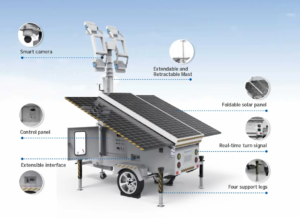
Vorteile: Umweltfreundlich, niedrige Betriebskosten, einfache Wartung.
- Features: 360°-Drehung und Beleuchtung
- Arbeitszeit: Bis zu 35 Stunden
Typische Anwendungen: Sonnige Regionen, geeignet für vorübergehenden oder langfristigen Beleuchtungsbedarf.
Repräsentative Modelle:
Solar-Beleuchtungsturm (mobil),
Solar-Lichtturm (Variante 2).
Wind- und Solar-Hybrid-Beleuchtungsturm
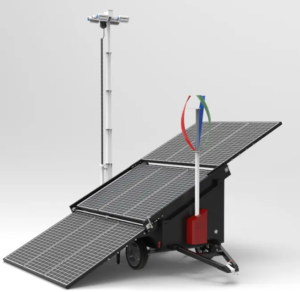
Vorteile: Liefert stabile Energie in windreichen Regionen.
- Besonderheiten: Bis zu 80 Stunden Betriebszeit
- Typische Anwendungen: Abgelegene Gebiete, Standorte mit reichlich Windressourcen, Notbeleuchtung nach Katastrophen
Repräsentative Modelle:
Sonne-Wind-Hybrid-Solar-Träger Und
Mobiler Solargenerator von Sunwind.
Diesel- und Solar-Hybridgeneratorturm
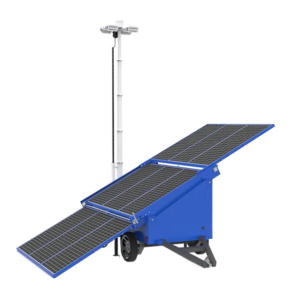
Vorteile: Stabile Energieversorgung in Gebieten ohne Netzanschluss.
- Besonderheiten: Bis zu 80 Stunden Laufzeit
- Typische Anwendungen: Abgelegene Bauarbeiten, Bergrettung, Logistikpunkte für Großveranstaltungen
Repräsentatives Modell:
Sundiesel Hybrid Solar Tailers.
Netzbetriebener Beleuchtungsturm
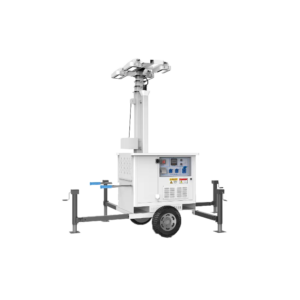
Vorteile: Stabile Energieversorgung dort, wo Stromnetze vorhanden sind.
- Effizienz: 195 lm/W Leuchteneffizienz
- Beleuchtete Fläche: 1.200 m²
- Arbeitszeit: 35 Stunden
- Typische Anwendungen: Großbaustellen, städtische Infrastrukturstandorte, Veranstaltungsorte
Repräsentatives Modell:
Elektrischer mobiler Lichtmast (T300, 6 m).
Schnellübersichts-Auswahltabelle
| Modell | Höhe | Abdeckungsbereich | Lichtleistung | Batteriekapazität | Laufzeit (typisch) | Energieoptionen |
|---|---|---|---|---|---|---|
| Kleiner Solarturm | 6 m | 750 m² | 33.000 lm | 9,6 kWh | ~28,8 h | Solar, Hybrid, Diesel, Netz (optional) |
| Mittlerer mobiler Leichtanhänger | 9 m | 1.500 m² | 66.000 lm | 14,4 kWh | ~20 Std. | Solar, Hybrid, Diesel, Netz (optional) |
| Großer tragbarer Lichtanhänger | 12 m | 2.200 m² | 198.000 lm | 28,8 kWh | ~20 Std. | Solar, Hybrid, Diesel, Netz (optional) |
Weitere Überlegungen
Wartung und Instandhaltung
- Regelmäßige Überprüfung von Leuchten und Batterien
- Saubere Photovoltaikmodule zur Aufrechterhaltung der Systemleistung
- Gewährleisten Sie die Gesamtzuverlässigkeit des Systems durch regelmäßige Überprüfungen
Anpassungsfähigkeit an die Umwelt
- Schutzart: Wählen Sie Leuchten mit hoher IP-Schutzart (z. B. IP65), um rauen Wetterbedingungen standzuhalten
Budget und Gesamtkosten
- Berücksichtigen Sie die Anschaffungskosten für die Ausrüstung, die Installation und die laufende Wartung, um die tatsächlichen Gesamtbetriebskosten zu ermitteln.
Die tragbaren Solarlichtmasten von Luxman nutzen hocheffiziente Solarmodule, langlebige Lithiumbatterien und leuchtstarke LED-Leuchten für eine stabile und langfristige Leistung. Luxman bietet auch Hybridmodelle (z. B. Solar+Wind, Solar+Diesel) für unterschiedliche Umgebungen und Anforderungen an.
Wenn Sie diese Richtlinien befolgen, können Sie den tragbaren Solar-Lichtturm von Luxman auswählen, der Ihren Anforderungen am besten entspricht und eine zuverlässige Beleuchtung und langfristige Leistung gewährleistet.
Sind Sie bereit, das perfekte Modell für Ihre Site zu finden? Kontaktieren Sie Luxman noch heute für eine maßgeschneiderte Lösung.

